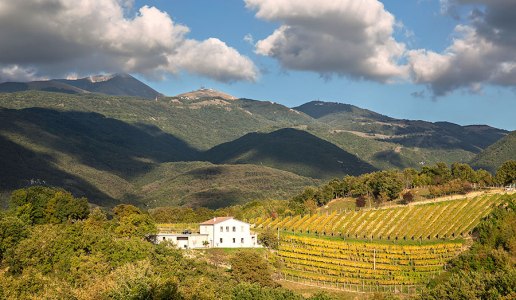Cantina Le Macchie, wines from the Rieti Hills

The enthusiasm of Antonio Di Carlo and his family led to the birth of this young winery, with a view of Monte Terminillo, which represents a pioneering endeavor.
The subtitle of Cantina Le Macchie’s explanatory technical leaflet is: “Wines from the Rieti Hills” and this basically sums up the estate in a nutshell. It is a short yet full of content and prickly difficulties. And this because they are convinced they can produce good wines where no one has done so before. They are convinced because they are in love with the land and the vineyards left to them by their grandparents which they – a family of good restauranteurs - feel obliged not to uproot but expand.
Having made this decision, they began to study, do geographic research and drink a lot of wine. This latter aspect was important because they are true wine lovers and collectors of important wines who will drink everything and they drink well. They also have a close relationship with the local chapter of the Italian Sommeliers’ Association (AIS) with whom they help promote wine events and tastings. They are also pragmatic and while they love native varietals they also cultivate international varieties. Work in the vineyard and winery has a very low impact on the environment but the Di Carlo family is not interested in branding their wines as organic or even natural. For them, what is important is to make wines that do not have technical defects and are, if possible, good and express the land. The project is only a few years old and not having winemaking neighbors to learn from, they have had to learn by trial and error and by comparing their wine to the others they have tasted.
The estate is in the Rieti Hills facing Monte Terminillo, in Castelfranco, a suburb of Rieti where the vineyards are situated at an altitude of between 610 to 650m above sea level and are often quite steep, making for challenging winegrowing. The vineyards with a southern exposure are cultivated with late-ripening grapes, while those with a southwest exposure have early-ripening ones. They produce nine wines which may be too many but listening to them talk about it becomes clear that they strong believe in each and every one and so who is to judge.
They work a lot with Cesanese Nero, a native grape that they practically saved from extinction, taking grafts from the last remaining vine that is 150 years old, even if it doesn’t look it. Pruning is done very carefully in order to obtain new shoots to graft and create new vines. The vineyards also have Montepulciano, Sangiovese and Merlot as well as the white varietals Trebbiano, Malvasia, Gewürztraminer and Rhine Riesling. The latter show how their whites do not follow tradition by were chosen based on the characteristics of the terroir. The microclimate, in fact, has the greatest temperature variation between day and night in Italy and thus well-suited for aromatic white wines.
The winey is not that small and has all the technological equipment necessary to produce good wines: temperature-controlled steel vats, a gas system to protect the must from oxidizing during fermentation, a small press, French barriques that have already been used six or seven times and only one big barrel, given that their production is not enough to fill another. Everything is clean and the wine is made by a skilled enologist and with much effort and a lot of humility. The result, for me, is that they are on the right path with wines that have no defects and are at least discreet with some even good. They still need some more experience and to focus more on precision in order to pinpoint what they are doing right and what they are doing wrong in order to resolve any problems. As I said before, while this may not seem difficult, if you do not have a territorial or family tradition to follow, or neighboring winemakers to compare you wine to, then it is anything but easy. At the same time, however, you do not have any domineering giants to overshadow you.
Altogether, they produce just over 40,000 bottles a year from a low-yield harvest. The prices are reasonable and we have decided to keep an eye on them because we are sure that sooner or later they will hit the bullseye.

 Italiano
Italiano











